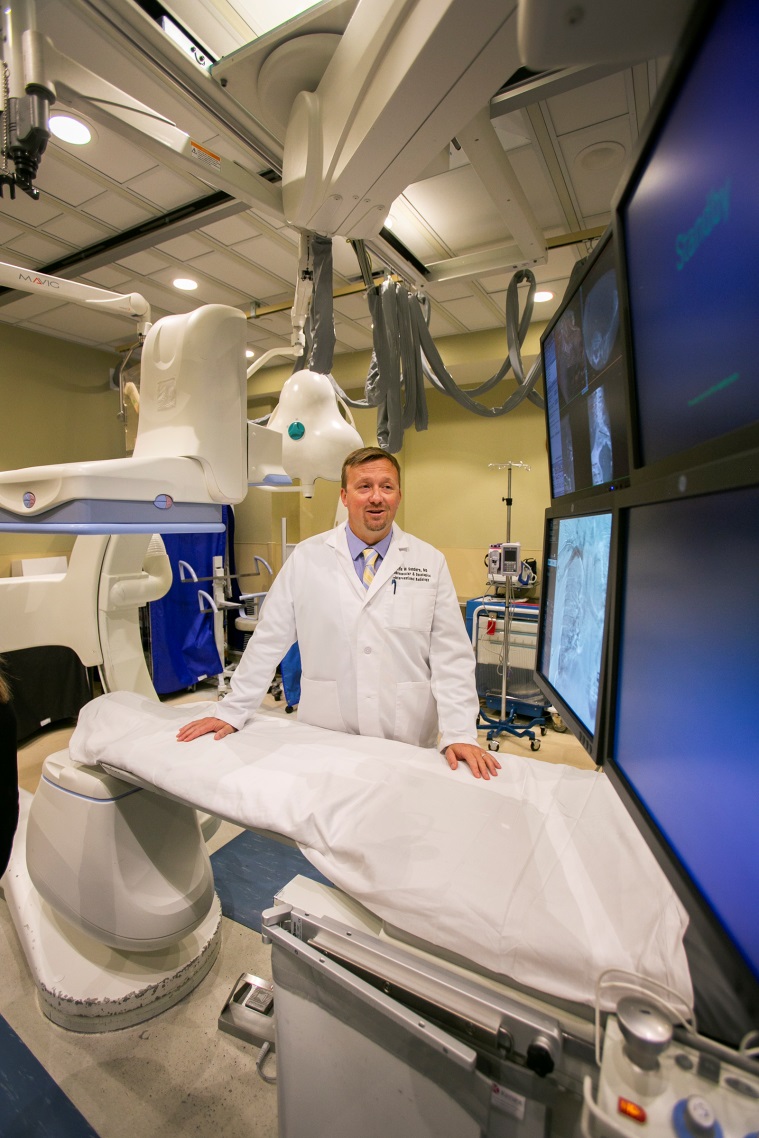As your community owned and operated hospital, San Juan Regional Medical Center is committed to bringing the latest technology and medical procedures here to our region so our patients and their families don’t have to travel out of the area for quality care. We are fortunate to have the only fellowship trained Vascular and Interventional Radiologist in the Four Corners performing some exciting, minimally invasive procedures as part of the exceptional cancer treatment we offer.
San Juan Regional Medical Center is proud to invest in the cutting-edge technology needed to be able to provide this high level of care for our community. Read on to learn more about what Dr. Kyle Sanders and our Radiology team are doing to truly change cancer patients’ lives.
Cancer patients in the Four Corners now have more options for innovative treatment right here at home to reduce tumors and even cure some types of cancer. Dr. Kyle Sanders, a fellowship-trained Vascular and Interventional Radiologist, subspecializes in minimally invasive image guided cancer therapy of the liver, kidney and bone. He’s the first and only radiologist in the Four Corners area providing these services to our community.
“San Juan Regional Medical Center has worked diligently over the last year to increase the services we provide to oncology patients in conjunction with our oncologists and radiation oncologists. It’s really exciting to be here and practicing this advanced level of medicine for our community,” Dr. Sanders said.
One of the new procedures Dr. Sanders is performing is liver-directed therapy for liver cancer, also known as Radioembolization or Y90. During this minimally invasive treatment, a patient is put under conscious sedation and a catheter is inserted through a small artery near the wrist and up into the liver. A radioactive particle is administered directly to the tumor. The patient is able to go home the same day with minimal side effects, mostly flu-like symptoms, and resume their normal activities while the radioactive particle goes to work killing the tumor.
“The tumors are shrinking by more than half in under three months. It’s really exciting,” Dr. Sanders said.
This treatment is also being used for other cancers that have metastasized to the liver, including colon cancer, breast cancer, and neuroendocrine tumors.
Another procedure Dr. Sanders is performing in conjunction with urologists in the area has seen high cure rates for smaller renal tumors. He places a small probe into the tumor in the kidney under CT guidance and freezes or burns the tumor. The treatment only takes about 20 minutes and the patient is able to go home the same day with almost no side effects. This treatment cures the cancer in 96 percent of the cases.
“Rarely do we ever have to retreat these patients,” Dr. Sanders said. “So in one session in radiology they are cured from a cancer and they can live their lives not worried about having a cancer anymore.”
Until Dr. Sanders started performing these cutting-edge treatments, cancer patients would have to travel to Albuquerque, Denver or Phoenix for these services. This puts a strain on patients to have to travel when they’re not feeling well, as well as a strain on their families. That burden can now be lifted.
“We can provide the same quality of service right here in our local community that you would otherwise have to go to a university hospital to get,” Dr. Sanders said. “San Juan Regional has made sure we have the latest, greatest equipment to provide this kind of patient care.”

Specialized equipment in the radiology operating room allows Dr. Sanders and his team to get CT scans during surgery so he can see 3D images in real time to help guide his therapies.
“For a rural hospital to have this type of technology shows a real commitment to providing a high level of care,” Dr. Sanders said.
If patients think they may benefit from the high level of care provided through these interventional radiology therapies, Dr. Sanders encourages them to speak to their physician.
“Most people don’t know what interventional radiology can do for them,” Dr. Sanders said. “The great thing about our community is we have top notch physicians who are aware of what we can provide and we all work together to benefit the patient.”